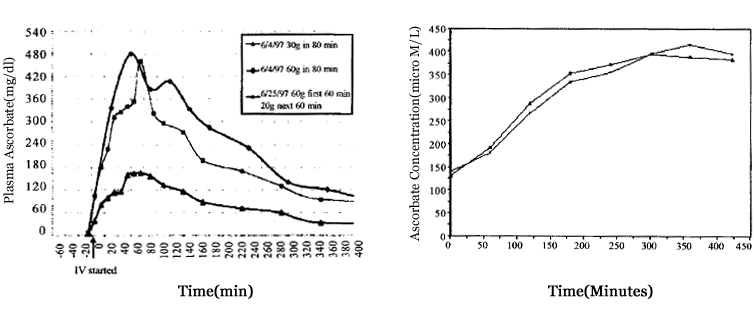통합 검색
통합 검색
REVIEW ARTICLE
Pharmacokinetics of Vitamin C: insights into the oral and intravenous
administration of ascorbate
JORGE DUCONGE, Ph D ; JORGE R. MIRANDA-MASSARI, Pharm D;
MICHAEL J. GONZALEZ, Ph D, DSC, FACNF; JAMES A. JACKSON, MT (ASCP) CLS, Ph D, BCLD (ABB);
WILLIAM WARNOCK, NDY; NEIL H. RIORDAN, Ph D, PA-C.
There is a strong advocacy movement for large doses of vitamin C. Some authors argue that the biological halflife for vitamin C at high plasma levels is about 30 minutes, but these reports are the subject of some controversy. NIH researchers established the current RDA based upon tests conducted 12 hours (24 half lives) after consumption. The dynamic flow model refutes the current low-dose recommendations for dietary intakes and links Pauling’s mega-dose suggestions with other reported effects of massive doses of ascorbate for the treatment of disease. Although, a couple of controlled clinical studies conducted at The Mayo Clinic did not support a significant benefit for terminal cancer patients after 10 grams of once-a-day oral vitamin C, other clinical trials have demonstrated that ascorbate may indeed be effective against tumors when administered intravenously. Recent studies confirmed that plasma vitamin C concentrations vary substantially |
with the route of administration. Only by intravenous
administration, the necessary ascorbate levels to kill cancer cells are reached in both plasma and urine. Because the efficacy of vitamin C treatment cannot be judged from clinical trials that use only oral dosing, the role of vitamin C in cancer treatment should be reevaluated. One limitation of current studies is that pharmacokinetic data at high intravenous doses of vitamin C are sparse, particularly in cancer patients. This fact needs prompt attention to understand the significance of intravenous vitamin C administration. This review describes the current state-of-the-art in oral and intravenous vitamin C pharmacokinetics. In addition, the governmental recommendations of dose and frequency of vitamin C intake will also be addressed. Key words: Vitamin C; Pharmacokinetics; Intravenous; Mega-Dose; Dynamic Flow. |

Figure 1. Vitamin C disposition profiles after intravenous infusions in a 72 years-old patient. This figure is electronically reprinted with permission from the International Society for Orthomolecular Medicine (ISOM), the publisher of Journal of Orthomolecular Medicine (taken from Riordan NH, Riordan HD, Casciari JP. Clinical and Experimental Experiences with Intravenous Vitamin C. J of Orthomolecular Medicine 2000; 15(4): 201-213) |
Figure 3. Truncated plasma pharmacokinetic profiles (absorption
|



